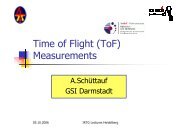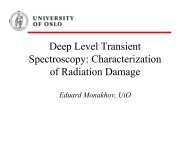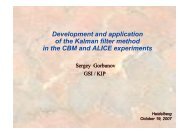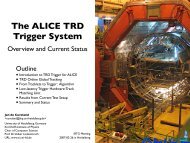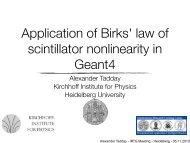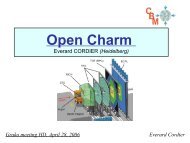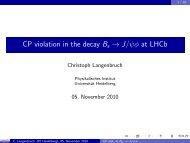Gas Detectors I - IRTG Heidelberg
Gas Detectors I - IRTG Heidelberg
Gas Detectors I - IRTG Heidelberg
Create successful ePaper yourself
Turn your PDF publications into a flip-book with our unique Google optimized e-Paper software.
<strong>Gas</strong> <strong>Detectors</strong> I<br />
Ulrich Uwer<br />
Physikalisches Institut<br />
• Introduction<br />
• <strong>Gas</strong> detector basics<br />
• MPWC<br />
• Drift chambers (LHCb straw detector)<br />
• Micro pattern detectors
<strong>Gas</strong> <strong>Detectors</strong> – A Frontier Technology<br />
Advantages • Cheap large area coverage<br />
Challenges<br />
• Good spatial resolution<br />
• Fast and large signals<br />
• Good dE/dx resolution<br />
• Good double track resolution<br />
• Many possible detector configurations<br />
• Low material budget – low radiation length<br />
• Extremely large area detectors needed (ATLAS 5500 m 2 )<br />
• High mechanical precisions (ATLAS, better than 30 µm)<br />
• Fast readout (25 ns bunch crossing cycle at LHC)<br />
• High rate capability (LHCb Straw Tracker 400 kHz/cm 2 )<br />
• High radiation dose (charge deposition ~2 C/cm)<br />
• Light construction (LHCb Straw Tracker 9% X 0 )<br />
Ulrich Uwer Universität <strong>Heidelberg</strong> 2
Example: ATLAS Muon Detector<br />
Monitored Drift Tubes (MDT)<br />
Sagitta s<br />
Ulrich Uwer Universität <strong>Heidelberg</strong> 3
Trigger on first cluster<br />
ATLAS MDTs<br />
Ulrich Uwer Universität <strong>Heidelberg</strong> 4
<strong>Gas</strong>eous <strong>Detectors</strong> at LHC<br />
Ulrich Uwer Universität <strong>Heidelberg</strong> 5
<strong>Gas</strong> ionization by charged particles<br />
Energy loss dE/dx of charged particles:<br />
- primary ionization<br />
- secondary ionization<br />
Total number of e/ion pairs for a particle:<br />
n =<br />
ion<br />
dE<br />
W<br />
dx<br />
ion<br />
+<br />
+<br />
+<br />
−<br />
−<br />
−<br />
Average energy<br />
W ion to create<br />
e/ion pair<br />
Bethe-Bloch<br />
Counting gas<br />
+ V<br />
CO 2<br />
Ulrich Uwer Universität <strong>Heidelberg</strong> 6<br />
<strong>Gas</strong><br />
Ar<br />
CH 4<br />
Z<br />
18<br />
33<br />
10<br />
For comparison:<br />
W ion [eV]<br />
26<br />
33<br />
28<br />
Minimum ionizing<br />
particle m.i.p<br />
n ion [cm -1 ]<br />
94<br />
91<br />
53<br />
Scintillator: energy for photon ~ 100 eV<br />
Si Detector: energy for e/hole ~ 3.5 eV
Drift of electrons in presence of fields<br />
Motion of charged particles under influence<br />
of E and B fields: Langevin equation.<br />
Drift velocity u:<br />
du<br />
m = e(<br />
E + u × B)<br />
− Ku<br />
dt<br />
“stochastic friction force” due to collisions<br />
m, e = mass and charge of electron<br />
du<br />
For t>>τ → static situation: = 0<br />
dt<br />
Cyclotron frequency Scalar mobility<br />
e<br />
ω = B<br />
m<br />
e<br />
µ = τ<br />
m<br />
u<br />
µ E<br />
= τ<br />
2 2<br />
1+<br />
ω τ<br />
[ ]<br />
Eˆ<br />
Eˆ<br />
Bˆ<br />
2 2<br />
+ ωτ × + ω ( Eˆ<br />
⋅ Bˆ<br />
) Bˆ<br />
Mean free path L<br />
Time between collisions:<br />
L 1<br />
τ = =<br />
c Nσ<br />
⋅c<br />
instantaneous velocity<br />
K<br />
One finds: τ =<br />
m<br />
for ωτ → 0 =<br />
E<br />
u µ<br />
Ulrich Uwer Universität <strong>Heidelberg</strong> 7
In the microscopic picture one finds for<br />
the drifting electrons (energy ε):<br />
drift<br />
Instant.<br />
2<br />
u =<br />
eE<br />
mNσ<br />
2 eE<br />
c =<br />
mNσ<br />
λ<br />
2<br />
2<br />
λ<br />
Drift velocity<br />
σ = σ(ε<br />
)<br />
λ = λ(ε<br />
)<br />
fractional<br />
energy loss<br />
(Energy received from the E field between<br />
collisions equal to energy transferred in collisions.)<br />
Elastic collisions:<br />
λ ≈<br />
2m −<br />
≈ 10<br />
Mgas<br />
2 2 c<br />
u c u ≈<br />
2 100<br />
4<br />
= λ Drift velocity much smaller<br />
than instantaneous velocity<br />
Ulrich Uwer Universität <strong>Heidelberg</strong> 8
Fast and slow gases<br />
Ramsauer<br />
minimum<br />
Excitation threshold: Ar at 11.5 eV<br />
• Ramsauer minimum: v is large<br />
• Ar: ε ionization >> ε Ramsauer<br />
• CH 4:<br />
ε exitation < ε Ramsauer<br />
• Ar / CH 4 mixture<br />
CH4 at 0.03 eV<br />
(vibrations+rotations)<br />
Ulrich Uwer Universität <strong>Heidelberg</strong> 9<br />
λ<br />
σ<br />
λ<br />
σ<br />
small, i.e. slow gas<br />
big, i.e. fast gas<br />
Drift velocity u can be tuned
Drift velocity of ArCH 4<br />
u [µm/ns]<br />
0/100<br />
50 µm/ns<br />
90/10<br />
50 µm/ns<br />
Ulrich Uwer Universität <strong>Heidelberg</strong> 10
• Fractional energy loss for ions large:<br />
2mionM<br />
λ ≈<br />
( m + M<br />
ion<br />
gas<br />
gas<br />
Drift velocity of ions<br />
)<br />
2 ≈<br />
• Mobility / drift velocity much smaller than<br />
for electrons.<br />
µ<br />
ion<br />
• While for electrons µ=µ(E, <strong>Gas</strong>, p, T) one<br />
finds for ions only little dependence on E:<br />
µ ( E)<br />
~ const v ~ E for small E<br />
µ ( E)<br />
~<br />
E<br />
−4<br />
≈ 10 µ<br />
e<br />
v<br />
~<br />
v<br />
1<br />
2<br />
ion<br />
E<br />
≈ 10<br />
−4<br />
u<br />
e<br />
for large E<br />
<strong>Gas</strong><br />
Ulrich Uwer Universität <strong>Heidelberg</strong> 11<br />
Ar<br />
Ne<br />
Xe<br />
Ion<br />
Ar +<br />
Ne +<br />
Xe +<br />
µ [cm 2 /(Vs)]<br />
1.5<br />
4.1<br />
0.6
Examples:<br />
• LHCb straw tubes: a=12.5 µm, b=2.5 mm<br />
• ATLAS MDT: a=25 µm, b=15 mm<br />
Proportional Counter<br />
E C<br />
r C<br />
Electrical field:<br />
V0<br />
1 C′<br />
V0<br />
1<br />
E(<br />
r ) = =<br />
ln( b / a)<br />
r 2πε<br />
r<br />
2πε 0 C′<br />
=<br />
ln( b / a)<br />
<strong>Gas</strong> amplification – avalanche:<br />
1<br />
1<br />
L = α<br />
α<br />
Ulrich Uwer Universität <strong>Heidelberg</strong> 12<br />
dn<br />
n<br />
e<br />
dx<br />
L<br />
e = = α<br />
dx<br />
0<br />
Capacity/length
General case of non-uniform fields<br />
G = exp( α(<br />
r ) dr )<br />
Raether limit:<br />
αx<br />
≈<br />
G<br />
20<br />
8<br />
~ 10<br />
rc<br />
a<br />
<strong>Gas</strong> amplification<br />
α(r) = Townsend coefficient<br />
G = k exp( C′<br />
V)<br />
Phenomenological limit:<br />
→ discharges (sparks)<br />
For uniform field<br />
n( r ) = n0<br />
exp( α r )<br />
n<br />
G =<br />
n<br />
= exp( α r )<br />
G = gas amplification = 10 4 … 10 5<br />
(gain)<br />
(LHCb straws)<br />
Ulrich Uwer Universität <strong>Heidelberg</strong> 13<br />
0
dG<br />
~ −<br />
G<br />
dG<br />
= −K<br />
G<br />
dρ<br />
ρ<br />
dp<br />
p<br />
Pressure dependence<br />
K = gas/configuration dependent constant = 5…8 Charge signal / rel. gain with<br />
mono chromatic γ source:<br />
Fe55: 6.9 keV γs<br />
Ulrich Uwer Universität <strong>Heidelberg</strong> 14
Gain drop at high particle<br />
densities: space charge<br />
around the anode.<br />
Space Charge Effect<br />
(LHCb straws)<br />
Ulrich Uwer Universität <strong>Heidelberg</strong> 15
2 nd Townsend Coefficient & Quencher<br />
UV photons from avalanche so far neglected:<br />
UV photons → photo effect (gas molecules / cathode)<br />
<strong>Gas</strong> amplification G γ<br />
G<br />
γ<br />
= G + G(<br />
γG)<br />
+ G(<br />
γG)<br />
including effect of UV photons:<br />
G<br />
+ .... =<br />
1−<br />
γG<br />
0× 1× 2× photo effect<br />
For γG → 1 : gas amplification becomes infinite<br />
2<br />
continuous discharges (sparks)<br />
Use poly-atomic gas admixtures to absorb photons: Quencher<br />
γ = probability for photo effect<br />
2 nd Townsend coefficient<br />
Ulrich Uwer Universität <strong>Heidelberg</strong> 16
Quencher<br />
Excitation cross section for Noble gases (Ar) and poly-atomic gases (CH 4 )<br />
Energy dissipation through collisions<br />
(radiation less transitions)<br />
Quencher: CH 4 , C 2 H 6 , CO 2 , CF 4<br />
Ulrich Uwer Universität <strong>Heidelberg</strong> 17
Operation modes<br />
I) Recombination before collection<br />
II) Ionization mode<br />
full charge collection, no charge<br />
multiplication.<br />
III) Proportional mode detector signal<br />
proportional to primary ionization, gas<br />
amplifications 10 4 …10 5 , needs<br />
quencher<br />
IV) Streamer mode<br />
strong photon emission produced<br />
secondary avalanche, strong<br />
quencher to localize streamer, large<br />
signals<br />
Geiger mode<br />
massive photon emission, no<br />
quencher → discharge over full<br />
length, needs to be stopped by HV<br />
drop<br />
Ulrich Uwer Universität <strong>Heidelberg</strong> 18
Absolute gain measurement<br />
HERA-B Honeycomb Tracker:<br />
Chamber current at a<br />
constant/stable irradiation for<br />
different HV (~10000 single<br />
channels contribute)<br />
~ 2 ×<br />
10<br />
Ulrich Uwer Universität <strong>Heidelberg</strong> 19<br />
4
Induced signal of charge Q moved by<br />
dr in a system with total capacity C=l·C’<br />
Electron signal<br />
Ion signal<br />
Total signal<br />
Signal development<br />
v<br />
v<br />
−<br />
+<br />
=<br />
=<br />
v = v<br />
−<br />
−<br />
+<br />
• Avalanche starts at a few radii distance<br />
from wire (typ. 50µm)<br />
• Electrons reach anode with ~1ns:<br />
Multiplication process takes less than 1ns<br />
• Ions will slowly drift towards cathode and<br />
induce a negative signal on anode<br />
Ulrich Uwer Universität <strong>Heidelberg</strong> 20<br />
dv<br />
Q a + d<br />
ln<br />
πε l a<br />
2 0<br />
Q b<br />
ln<br />
πε l a + d<br />
2 0<br />
+ v<br />
−<br />
=<br />
−<br />
Q<br />
ln<br />
πε l<br />
2 0<br />
Q<br />
=<br />
lC′<br />
V<br />
b<br />
a<br />
0<br />
dV<br />
dr<br />
dr<br />
Assumes all charge produced<br />
at distance d<br />
Q<br />
= −<br />
lC′<br />
− +<br />
v v<br />
≈ 1.<br />
4 ( 1)%<br />
for LHCb straws<br />
/ ATLAS MDT
Ion signal<br />
Signal rise time<br />
Signal timing<br />
Q ( t)<br />
= Q0<br />
ln( 1+<br />
t / t0)<br />
/ ln( 1+<br />
tmax<br />
/ t0)<br />
t<br />
0<br />
=<br />
2<br />
pa<br />
2µ<br />
V<br />
ln( b / a)<br />
~ 5ns<br />
p(<br />
b − a )<br />
Max. ion drift time tmax<br />
= ln( b / a)<br />
~ 130µ<br />
s<br />
µ V<br />
Q /Q0<br />
2<br />
p = pressure<br />
V = voltage<br />
µ = ion mobility<br />
Ulrich Uwer Universität <strong>Heidelberg</strong> 21<br />
2<br />
t<br />
[ns]<br />
LHCb straws
∆V<br />
Signal readout<br />
t<br />
C1<br />
R >><br />
2 C2,<br />
R2C1<br />
t0<br />
“Voltage source”<br />
[ns]<br />
+ V<br />
Ulrich Uwer Universität <strong>Heidelberg</strong> 22<br />
I<br />
R1<br />
C2<br />
R2<br />
R
Long ion tail will shadow<br />
subsequent ionizing particles:<br />
If threshold for particle detection is<br />
used, signal stays long time above<br />
threshold.<br />
RC/CR Shaping<br />
Signal Shaping<br />
“Current mode”<br />
Signal after shaping<br />
Signal after amplifier<br />
Ulrich Uwer Universität <strong>Heidelberg</strong> 23
Ageing Effects<br />
In a high rate environment (e.g. LHC) wire chambers could show several<br />
“ageing effects”, nearly all of them triggered by pollutants in the gas/chamber:<br />
• Deposits on the anode wire:<br />
→ gain loss<br />
Study gain as function of totol<br />
charge deposition per length<br />
(LHCb straw detector)<br />
Ulrich Uwer Universität <strong>Heidelberg</strong> 24
• Etching of anode wire in case of<br />
counting gas with CF 4 admixtures<br />
(LHCb straws)<br />
Ageing Effects II<br />
• Modification of the cathode surface:<br />
Malter effect → self sustaining currents<br />
(HERA-B, Honeycomb tracker)<br />
Ulrich Uwer Universität <strong>Heidelberg</strong> 25
Tools for detector development<br />
Garfield - simulation of gaseous detectors<br />
http://consult.cern.ch/writeup/garfield/<br />
Garfield is a computer program for the detailed simulation of twoand<br />
three-dimensional drift chambers<br />
Magboltz - Transport of electrons in gas mixtures<br />
http://consult.cern.ch/writeup/magboltz/<br />
Magboltz solves the Boltzmann transport equations for electrons<br />
in gas mixtures under the influence of electric and magnetic fields.<br />
Heed - Interactions of particles with gases<br />
http://consult.cern.ch/writeup/heed/<br />
HEED is a program that computes in detail the energy loss of fast charged<br />
particles in gases, taking delta electrons and optionally multiple scattering of<br />
the incoming particle into account. The program can also simulate the<br />
absorption of photons through photo-ionization in gaseous detectors.<br />
Ulrich Uwer Universität <strong>Heidelberg</strong> 26
Multi Wire Proportional Chamber<br />
Charpak, 1967/68<br />
Nobel prize 1992<br />
spatial resolution<br />
~ s<br />
12<br />
With typ. wire distance<br />
s≈2mm δs ≈ 0.6 mm<br />
Significantly better spatial<br />
resolution in not achievable<br />
with MWPCs<br />
E Field<br />
MPWC = Multiwire proportional chambers<br />
Ulrich Uwer Universität <strong>Heidelberg</strong> 27
Drift Chamber<br />
• Drift time drift distance and intersection point of particle<br />
• Spatial resolution of ~100 µm achievable<br />
Ulrich Uwer Universität <strong>Heidelberg</strong> 28
Ulrich Uwer Universität <strong>Heidelberg</strong> 29
Physikalisches<br />
Institut,<br />
<strong>Heidelberg</strong>, 1971<br />
First Drift Chamber<br />
Ulrich Uwer Universität <strong>Heidelberg</strong> 30
LHCb Outer Tracker<br />
Ulrich Uwer Universität <strong>Heidelberg</strong> 31
Outer Tracker - Demands<br />
Ulrich Uwer Universität <strong>Heidelberg</strong> 32
Planar Tracking Stations<br />
5 m<br />
T1 T2 T3<br />
264 Module<br />
6 m<br />
1.3% area<br />
20% tracks<br />
Outer<br />
Tracker<br />
Ulrich Uwer Universität <strong>Heidelberg</strong> 33
Straw tube drift chamber modules<br />
5mm cells<br />
pitch 5.25 mm<br />
Straw Tubes<br />
e<br />
- e -<br />
e<br />
-<br />
Track<br />
2.5 m<br />
Cathode<br />
Straw tube winding:<br />
Lamina Dielectrics Ltd.<br />
Ulrich Uwer Universität <strong>Heidelberg</strong> 34
Module Construction<br />
2 × =<br />
Ulrich Uwer Universität <strong>Heidelberg</strong> 35
Drift time spectrum<br />
Ulrich Uwer Universität <strong>Heidelberg</strong> 36
Wire Chambers -Summary<br />
• Technology widely used in HEP experiments<br />
• Proven to be robust, precise and reliable devices<br />
• Detector geometry and counting gas can be tuned and<br />
optimized to fulfill requirements of the given application<br />
• Play an important role in all LHC detectors<br />
• Will continue to used in future particle detector:<br />
ILC detector PANDA, CBM<br />
Ulrich Uwer Universität <strong>Heidelberg</strong> 37
Micro pattern detectors<br />
• Micromegas<br />
• GEM detectors<br />
Ulrich Uwer Universität <strong>Heidelberg</strong> 38
Micromegas<br />
Ulrich Uwer Universität <strong>Heidelberg</strong> 39
<strong>Gas</strong> Electron Multiplier (GEM)<br />
triple GEM<br />
double GEM<br />
Single GEM<br />
140 µm<br />
Ulrich Uwer Universität <strong>Heidelberg</strong> 40
Compass Triple-GEM<br />
Ulrich Uwer Universität <strong>Heidelberg</strong> 41
Novel Neutron Detector<br />
Ulrich Uwer Universität <strong>Heidelberg</strong> 42
CASCADE Neutron Detector<br />
Ulrich Uwer Universität <strong>Heidelberg</strong> 43
Detector development tools<br />
Ulrich Uwer Universität <strong>Heidelberg</strong> 44



